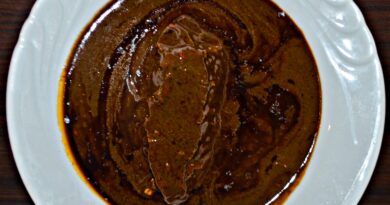Ugali
Ugali: The Heart and Soul of East African Cuisine
Introduction:
In the vibrant tapestry of East African cuisine, one dish stands out as a true embodiment of sustenance, culture, and tradition – Ugali. This simple yet iconic dish, often referred to as the staple of East Africa, has been a dietary cornerstone for generations. Join us on a culinary journey as we explore the origins, preparation methods, and cultural significance of Ugali, delving into the rich history that has made it an integral part of the region’s culinary identity.
Origins and Historical Significance: The Roots of Ugali
Indigenous Roots:
Ugali’s origins can be traced back to the indigenous communities of East Africa, where it evolved as a practical and versatile dish crafted from locally available ingredients. Its simplicity reflects the resourcefulness of East African cultures, adapting to the agricultural bounty of the region.
Cultural Diversity:
Ugali transcends national borders, with variations of the dish found in countries such as Kenya, Tanzania, Uganda, Rwanda, and beyond. Its adaptability to different regional preferences showcases the diversity within East African culinary traditions.
Ingredients and Preparation: The Art of Making Ugali
Main Ingredients:
- Maize Flour (Cornmeal): The primary ingredient in Ugali, maize flour, is the cornerstone of this dish. Its widespread availability and affordability make Ugali accessible to people across East Africa.
- Water: The simple combination of maize flour and water forms the basis of Ugali. The proportions may vary, but the essence remains the same.
Preparation Method:
- Boiling Water: In a pot, water is brought to a boil. The quantity of water used determines the consistency of Ugali, ranging from a firm, dough-like texture to a softer, porridge-like consistency.
- Gradual Addition of Maize Flour: Maize flour is gradually added to the boiling water while stirring continuously. This process is crucial to avoid lumps and ensure a smooth, uniform texture.
- Continuous Stirring: The mixture is stirred continuously, allowing it to thicken and reach the desired consistency. This rhythmic stirring is an art in itself, requiring skill to achieve the perfect balance.
- Shaping and Serving: Once the desired consistency is reached, Ugali is shaped into a mound or formed into individual portions. It is often served on the side of a main dish, acting as a neutral base for a variety of flavorful accompaniments.
Ugali Variations: A Culinary Kaleidoscope
Regional Flair:
While the core ingredients of Ugali remain consistent, regional variations offer a diverse range of flavors and textures. In Kenya, it is known as Ugali, in Tanzania as Ugali, and in Uganda as Posho or Sima. Each country has its unique approach to preparing and enjoying this beloved dish.
Accompaniments:
Ugali is rarely enjoyed on its own; rather, it serves as a versatile canvas for an array of accompaniments. Common pairings include:
- Sukuma Wiki (Collard Greens): A nutritious and vibrant green vegetable often sautéed with onions and spices.
- Nyama Choma (Grilled Meat): Barbecued meat, a popular East African delicacy, pairs perfectly with Ugali.
- Fish Stew: In coastal regions, Ugali is complemented by a rich fish stew, incorporating the bounty of the sea.
Cultural Significance: Ugali as a Symbol of Community and Identity
Communal Dining:
Ugali is often enjoyed in communal settings, where a large mound of the dish is placed at the center of the table. This communal style of dining fosters a sense of togetherness, emphasizing the importance of shared meals in East African cultures.
Celebratory Occasions:
Whether it’s a family gathering, a wedding celebration, or a cultural ceremony, Ugali takes center stage during important occasions. Its presence symbolizes abundance, unity, and the shared cultural heritage of the community.
Daily Nourishment:
Beyond celebrations, Ugali is a daily staple for many East Africans. Its affordability and nutritional value make it an essential component of the daily diet, providing sustenance and energy for various activities.
Ugali in Modern Times: A Dish That Transcends Generations
Culinary Fusion:
In contemporary East African kitchens, chefs are reimagining Ugali with creative twists and fusions. From incorporating alternative grains to experimenting with diverse cooking techniques, Ugali is adapting to modern tastes while retaining its cultural roots.
Nutritional Awareness:
As the world becomes more health-conscious, Ugali’s nutritional benefits are gaining recognition. It serves as an excellent source of energy, dietary fiber, and essential nutrients, aligning with the growing emphasis on balanced and wholesome diets.
Culinary Tourism: Ugali on the Global Stage
International Recognition:
As culinary tourism gains popularity, Ugali is emerging as a symbol of East African gastronomy on the global stage. Travelers seeking authentic culinary experiences are drawn to the simplicity and depth of flavor that Ugali offers.
Restaurant Appearances:
Ugali is making appearances on international restaurant menus, introducing global diners to the authentic taste of East African cuisine. Its versatility and ability to pair with a variety of dishes make it a unique and intriguing addition to diverse culinary landscapes.
Conclusion: Ugali – More Than a Meal, a Cultural Legacy
Ugali is more than a dish; it is a cultural legacy that has stood the test of time, weaving itself into the fabric of East African identity. As a symbol of resilience, community, and the rich agricultural heritage of the region, Ugali continues to hold a special place in the hearts and homes of millions.
Whether enjoyed in the intimacy of a family dinner or at the center of a festive gathering, Ugali remains a testament to the enduring traditions and the unifying power of food. As East Africa evolves, Ugali stands as a culinary icon, reminding us that the simplest of dishes can carry the weight of history, culture, and the shared stories of generations past and those yet to come.



